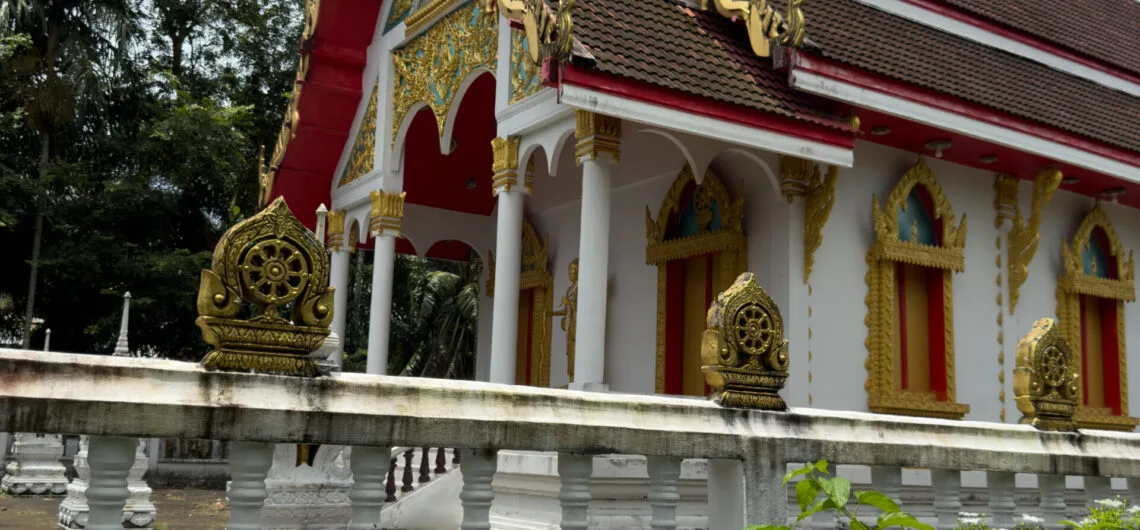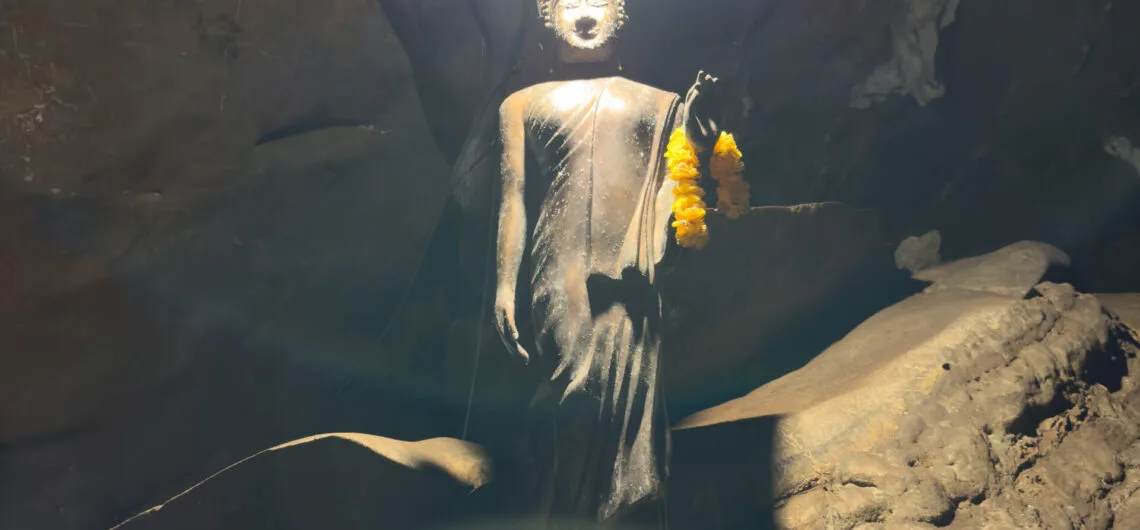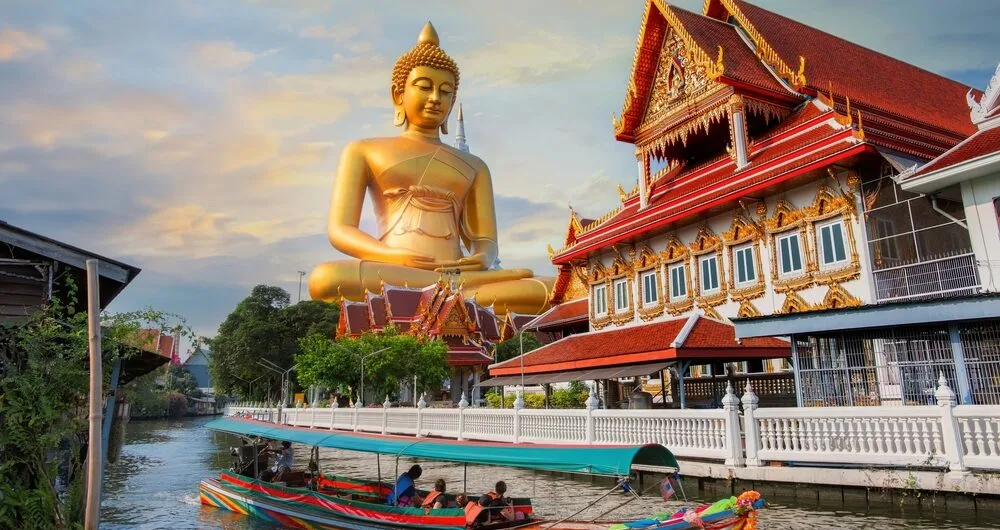
Looking for a temple experience that goes beyond the usual tourist trail? Wat Ma Pring in Phang Nga might just be what you’re after. Tucked away in Thailand’s serene Phang Nga province, this hidden gem offers a peaceful retreat from the crowds. Whether you’re a spiritual seeker, a cultural enthusiast, or someone looking to soak in local charm, Wat Ma Pring has something special to offer. Join Resurgence Travel on this journey as we uncover the layers of history, culture, and spirituality that make Wat Ma Pring a unique destination.
A Glimpse into History: Wat Ma Pring’s Deep Roots
Let’s start with a bit of background. Wat Ma Pring isn’t just another temple in Thailand; it’s a place where history and local culture come alive. The name “Ma Pring” refers to the bilimbi tree, a lesser-known fruit in English but beloved in local Thai cooking for its sour punch. The temple has been around for centuries, standing as a testament to the resilience and faith of the local community. Wat Ma Pring has served as a shelter, a place of worship, and a hub for communal activities over the years. Its story is interwoven with the lives of the villagers, making it a living piece of history.
So, if you’re traveling with Resurgence Travel, get ready to step back in time and experience a slice of authentic Thai culture that you won’t find in guidebooks.
Architecture that Tells a Story: Traditional Meets Local
Wat Ma Pring’s architecture is a blend of traditional Thai design with local influences. The main hall, or “Ubosot,” is crafted from solid teak wood and adorned with detailed carvings that depict stories from the life of the Buddha. Look closely, and you’ll notice carvings of local flora and fauna, including the bilimbi tree. This detail ties the temple even closer to its natural surroundings.
The roof, covered with terracotta tiles, adds a rustic charm that’s common in Southern Thai temples. The Naga serpent motifs on the gables symbolize protection and wisdom—a nod to Thailand’s rich mythological heritage. The open-air pavilion, or “Sala,” is another standout feature. It’s a perfect spot for communal gatherings and quiet meditation, offering stunning views of the surrounding hills and rice fields. The use of natural materials like wood and stone makes it feel like the temple is part of the landscape itself.
Visiting Wat Ma Pring with Resurgence Travel means experiencing a space that’s not just beautiful but also deeply connected to its environment.

Spiritual Vibes: A Tranquil Sanctuary
While Wat Ma Pring might not offer formal meditation retreats, its tranquil environment is perfect for personal reflection. The temple is a sanctuary where visitors can sit quietly, meditate, or simply soak in the peaceful vibes. Inside, you’ll find several revered Buddha images, each telling a different story from the Buddha’s life and teachings. The most notable is a seated Buddha statue in the main hall, believed to be over 200 years old. Pilgrims come from near and far to pay their respects and seek blessings.
Resurgence Travel emphasizes unique experiences, and here, you can experience spiritual tranquility at your own pace, without the need for structured retreats.

Cultural Hub: More Than Just a Temple
Wat Ma Pring isn’t just about spirituality; it’s a cultural cornerstone for the Phang Nga community. The temple is actively involved in preserving and promoting local traditions, hosting several cultural events and festivals throughout the year. These events bring the community together to celebrate their shared heritage and pass down cultural practices to younger generations.
One highlight is the annual Kathina ceremony, where locals offer new robes to the monks. This event is not just a religious observance but a vibrant cultural celebration filled with traditional music, dance, and food. It draws people from surrounding villages and even tourists eager to experience authentic Thai culture.
The temple also plays a role in education. It provides free schooling for children from underprivileged backgrounds, teaching them both academic and spiritual subjects. This commitment aligns perfectly with Resurgence Travel’s mission to foster meaningful cultural engagement and promote education.

Accessibility and Preservation: A Hidden Gem with Easy Access
Getting to Wat Ma Pring is straightforward. Located just a short drive from the town center of Phang Nga, the temple is easily accessible by road. Despite its convenience, Wat Ma Pring remains a hidden gem, largely untouched by mass tourism. This makes it an ideal spot for those traveling with Resurgence Travel who are looking for a more personal and contemplative temple experience.
The temple grounds are meticulously maintained, with a strong emphasis on preserving both the built heritage and the natural environment. The monks and lay volunteers work tirelessly to ensure that the temple and its surroundings remain pristine. There are well-marked paths and signage around the temple, making it easy for visitors to navigate and explore the various buildings and statues.
Efforts to preserve the natural landscape around Wat Ma Pring have also been a priority. The temple gardens are lush with indigenous plants and trees, including bilimbi trees, which are a key feature of the temple’s identity. There are ongoing initiatives to protect the local wildlife and promote biodiversity. These efforts not only enhance the temple’s aesthetic appeal but also underline its commitment to environmental stewardship.


What to Expect: An Immersive Visitor Experience with Resurgence Travel
Visiting Wat Ma Pring offers a rich and rewarding experience that goes beyond mere sightseeing. The temple provides an intimate glimpse into local spiritual and cultural life, allowing visitors to engage directly with the traditions and practices that define the community. Whether it’s engaging in personal meditation, learning about traditional Thai herbal medicine from the monks, or simply enjoying the serene beauty of the temple grounds, there is something for everyone at Wat Ma Pring.
For those interested in learning more about Buddhism, Wat Ma Pring offers informal talks and discussions led by the monks. These sessions provide a deeper understanding of Buddhist philosophy and practices, as well as an opportunity to ask questions and engage in meaningful dialogue. The temple also offers guided tours, which are an excellent way to learn about the history and significance of the various buildings and statues on the temple grounds.
The temple’s relaxed and welcoming atmosphere makes it an ideal place for a day trip or a longer stay. While there are no formal accommodations for tourists, the nearby town of Phang Nga offers various lodging options for those wishing to extend their stay and explore more with Resurgence Travel.
Going Green: Sustainability Efforts at Wat Ma Pring
Wat Ma Pring is committed to sustainability, a value that aligns closely with Resurgence Travel’s focus on responsible tourism. The temple has embraced several eco-friendly practices, like using solar panels for energy, collecting rainwater for the gardens, and promoting recycling and waste reduction. These efforts are deeply rooted in Buddhist teachings on mindfulness and respect for all living beings.
The temple’s community garden is another example of its commitment to sustainability. The garden is maintained using organic farming methods and provides fresh produce for the temple kitchen and local families. Visitors can even get their hands dirty by helping out in the garden, learning about sustainable agriculture in the process. It’s a unique, hands-on experience that underscores the temple’s—and Resurgence Travel’s—commitment to sustainability.

Engaging with the Community: A Cultural Exchange
Wat Ma Pring is a cultural engagement hub, actively promoting understanding and exchange. The temple regularly hosts workshops on traditional Thai arts and crafts, such as Thai massage, herbal medicine, and classical dance. These programs are open to both locals and visitors, offering a fantastic opportunity for cultural exchange. It’s a place where tradition and modernity meet, creating a vibrant cultural center.
Resurgence Travel encourages participation in these activities, providing a richer, more authentic travel experience that goes beyond typical sightseeing.
Ratings Recap: How Wat Ma Pring Scores with Resurgence Travel
Let’s break down how Wat Ma Pring scores using our Resurgence Travel rating system:
Historical Significance: 3.5/5
Wat Ma Pring has a rich local history, but it’s not as prominent as more famous temples like Wat Arun.
Architectural Uniqueness: 3.5/5
The blend of traditional Thai architecture with local influences is notable, though not as striking as the grander temples.
Spiritual Value: 3/5
While it offers a peaceful environment for personal reflection, it does not provide formal meditation retreats.
Cultural Impact: 4/5
The temple plays a significant role in preserving and promoting local culture, though its influence is mostly regional.
Accessibility and Preservation: 4.5/5
Easy to reach and well-preserved, offering a more intimate experience away from the crowds.
Visitor Experience: 3.5/5
Offers an immersive experience, but lacks formal accommodations and extensive facilities.
Sustainability Efforts: 4.5/5
Strong commitment to environmental sustainability, with notable eco-friendly practices.
Cultural Engagement: 4/5
Promotes cultural exchange and understanding, but on a smaller scale compared to larger, more tourist-focused temples.Overall Score: 3.8/5
Why Wat Ma Pring Should Be on Your Resurgence Travel List
Wat Ma Pring in Phang Nga is more than just a temple; it’s a journey into the heart of Thailand’s spiritual and cultural soul. With its rich history, unique architecture, and deep-rooted community ties, this temple offers a distinctive experience that stands apart from more commercialized sites. Whether you’re traveling with Resurgence Travel for spiritual reflection, cultural exploration, or a bit of both, Wat Ma Pring provides an authentic taste of Thailand’s Buddhist traditions and local life.
Although it may not have the grandeur of temples like Wat Arun in Bangkok, Wat Ma Pring’s charm lies in its simplicity and serene atmosphere. This is a place where you can slow down, breathe deeply, and immerse yourself in a more personal, off-the-beaten-path experience. For travelers looking for a meaningful encounter with Thailand’s culture and spirituality, Wat Ma Pring is a must-visit destination.
So, if you’re planning your next adventure with Resurgence Travel, make sure to add Wat Ma Pring to your itinerary. It’s a hidden gem that’s ready to welcome you with open arms and a tranquil spirit.








































